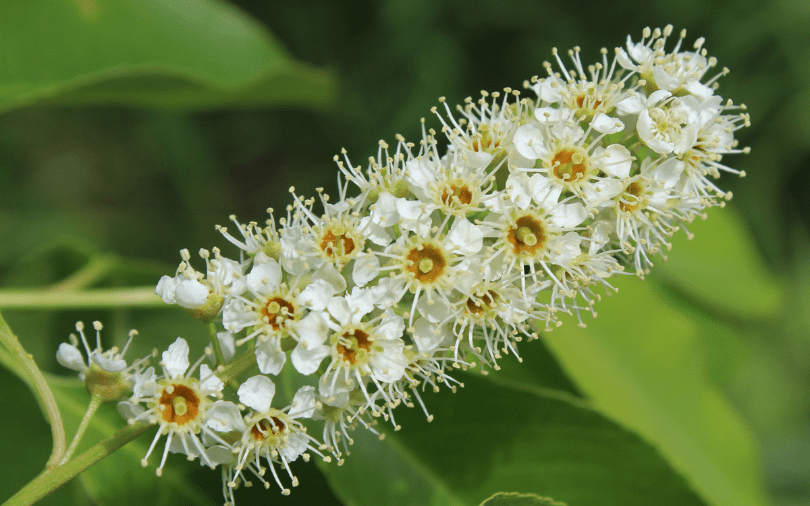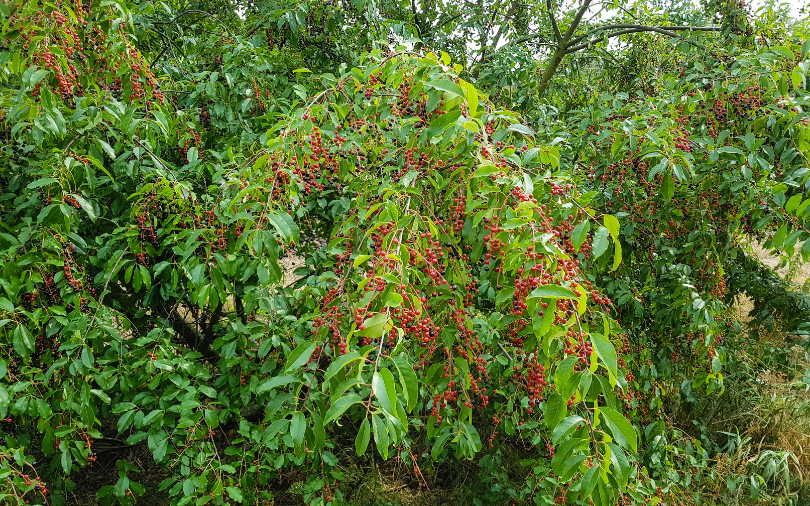Escarpment Black Cherry (Prunus serotina) trees can be a beautiful, native, addition to any landscape in San Antonio, Texas. These deciduous trees develop glossy, green leaves and delicate white flowers in the spring, and small dark cherries that birds love to feast on. The black cherries also make some very tasty jams, jellies, pies and even wine as well. Each cherry ripens individually so you see multiple stages (coloring) of them ripening; sometimes even while being on the same cluster!

The green leaves that appear spring through summer, become a fall spectacular when they become a brilliantly glowing, golden-yellow in fall. These durable and tough trees grow to an average height of about 30-40′, and boast some of the most gorgeous bark you’ll see. The rich, red tint of the wood is sought after in furniture.
A pollinator delight, the tree boasts flowers that attract with their nectar and the foliage is a host to multiple species of butterflies and moths. We already mentioned how much the birds love the fruit. What you do need to be mindful of is that all parts of the tree, except the fruit if they are pitted, are poisonous. So this is not the tree for you if you have animals, or children, that tend to pick up twigs and leaves and taste them a little. Keep leaf and twig litter picked up and discarded.
A pollinator delight, the tree boasts flowers that attract with their nectar and the foliage is a host to multiple species of butterflies and moths. We already mentioned how much the birds love the fruit. What you do need to be mindful of is that all parts of the tree, except the fruit if they are pitted, are poisonous. So this is not the tree for you if you have animals, or children, that tend to pick up twigs and leaves and taste them a little. Keep leaf and twig litter picked up and discarded.

When growing escarpment black cherry trees in San Antonio, it’s important to choose a sunny spot with well-draining soil. These trees thrive in full sun and can tolerate the hot Texas summers. Make sure to water them regularly, to get them established so they can develop strong root systems. Extra watering may be required during long, hot, periods of drought to prevent the tree from going into an early deciduous phase.
One of the best things about growing escarpment black cherry trees is that they require minimal maintenance once established. Pruning is only necessary to remove dead or damaged branches and to shape the tree if desired. These trees are also relatively pest and disease resistant, making them a low-fuss option for your garden.
Imagine enjoying the sight of delicate blossoms in the spring, the sound of birds chirping as they enjoy the cherries in the summer, and the beautiful foliage changing colors in the fall. Growing escarpment black cherry trees can bring a touch of nature’s beauty right to your backyard in San Antonio, Texas.
These are rare to find and we’ve only been able to bring in a small amount at our Bandera store, so if they’ve been on your list, come visit soon; I mean like real soon!
~The Happy Gardener, Lisa Mulroy


To what cold temperature can these trees stand?
They can tolerate temperatures as low as 12° to 22° F in winter. Sustained cold temperatures between 32-27 °F while the tree is blooming can damage up to 90% of its flowers. So if we have some random weird cold spell in spring that lasts for days, that’s the only thing you really have to be concerned with. And that rarely happens.
It’s a butterfly host plant also!
Yes, to multiple species of butterflies and moths! Yay Pollinators!
Thank You
Of course, happy to share!
Please let me know when are available!!!🙏
Will do.
Same! Hoping by replying to this thread that we’ll be notified when these are available in Spring 2025. Excited to make this a part of my garden.
We’ll keep you in the loop.